Birds are yellow, birds are black, but are there any purple birds? The answer is yes, and we’re not talking about animated movies.
From different countries and living in various habitats, purple colored birds beautify our world with their unique plumage. They make a part of the ecosystem, and these exotic birds are a lovely sight to see.
Purple birds include the purple-breasted cotinga, purple honeycreeper, purple martin, violet-backed starling, and a host of others.
Many of them have a combination of different colors alongside purple, like the purple and green bird, purple and yellow bird, etc.
This article presents a list of 30 purple bird species! Their amazing colors and feathers make them part of nature’s beauty, and we’re sure you’d get to love them more as you read on.
Fun Fact: Studies show that birds that live closer to the equator (tropical birds) are generally more colorful than their polar counterparts.
List of Purple Birds
1. Purple-breasted Cotinga
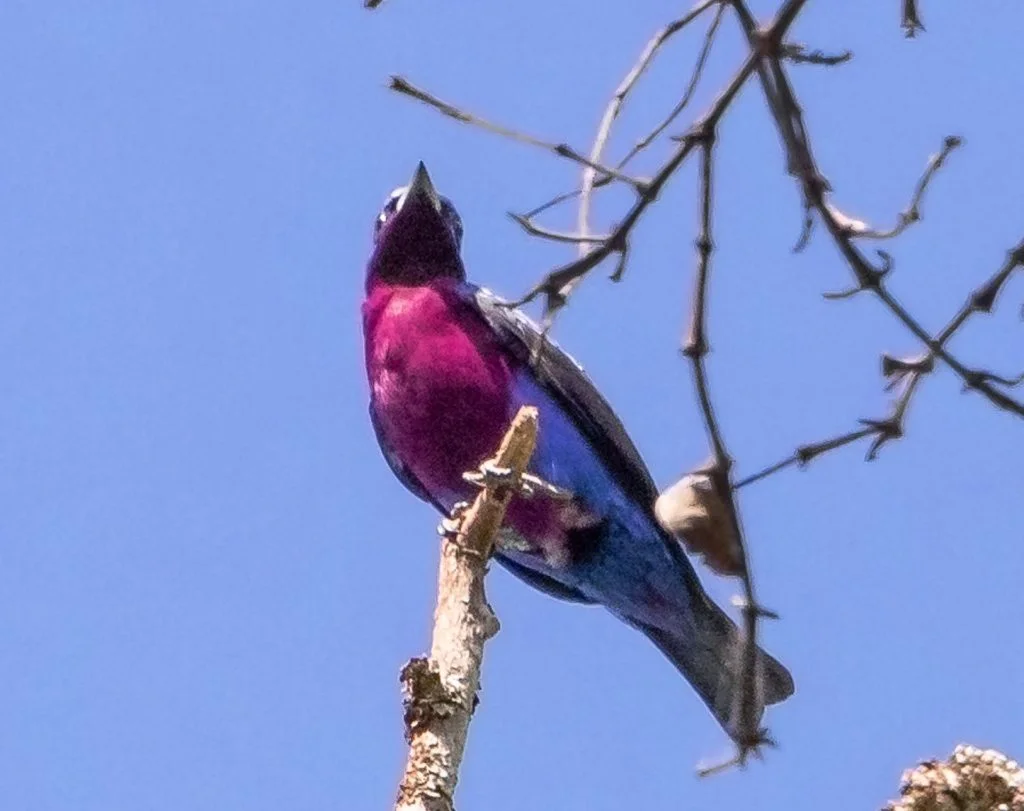
- Scientific Name: Cotinga Cotinga
- Range: Brazil, Colombia, French Guiana, Guyana, Peru, Suriname, Venezuela
- Habitat: Moist Lowland Forests
- Conservation Status: Least Concern
The purple-breasted cotinga is from the family Cotingidae, a family of cotingas that boasts of over 100 species. The purple-breasted cotinga loves forests, especially rainforests with moistness.
The purple color helps them camouflage from any potential predator, and it also serves as a good mating tool. Like every other bird species in the Cotingidae, this cotinga species is frugivorous (their diet consists of fruits).
In size, it grows up to 13 inches and weighs between 32 and 39g. As the name shows, the purple-breasted cotinga has purple color running through the breast area, alongside the wings, head, neck, and back.
2. Purple Honeycreeper
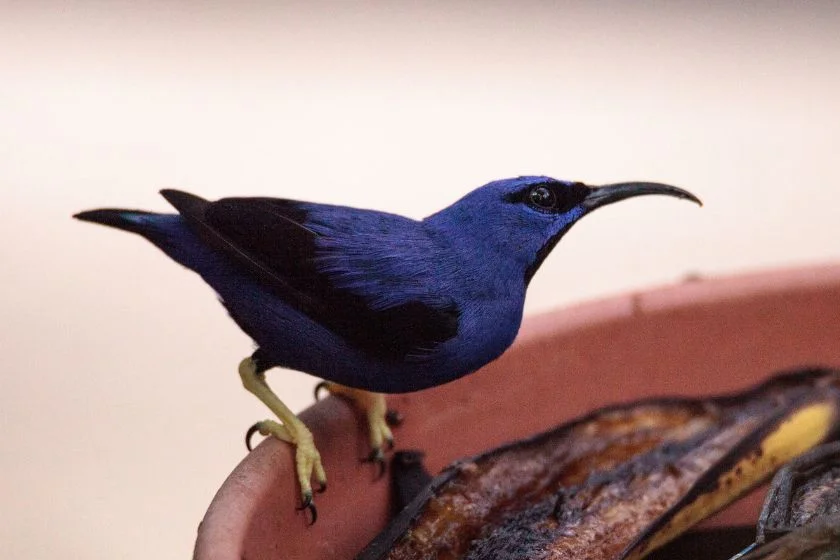
- Scientific Name: Cyanerpes caeruleus
- Range: Colombia, Venezuela, Trinidad, and Tobago
- Habitat: Forests, plantations
- Conservation Status: Least Concern
The purple honeycreeper is in the family Thraupidae, also known as the tanager family. It is mainly found in South America, often in the northern parts of the continent.
Its main habitat is forest canopies, but it also lives in plantations, especially cocoa and citrus. These birds are small, with a height of 4.5 inches and a weight of 12g.
They are social birds that stay in small groups, and like butterflies, they feed on plant nectars. They also feed on fruits, insects, and seeds. Males have more purple colors than females which tend to be green.
3. Purple Martin
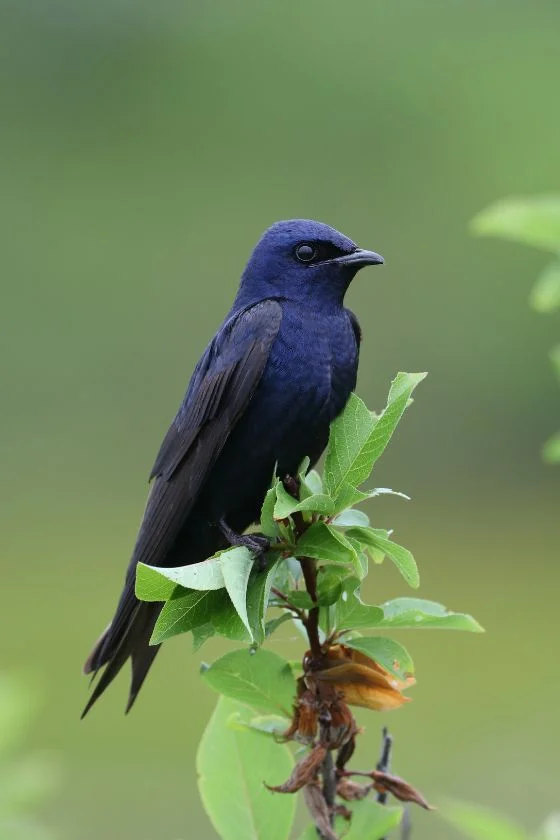
- Scientific Name: Progne Sabis
- Range: North America
- Habitat: Open areas
- Conservation Status: Least Concern
The purple martin is the largest swallow in North America, and it belongs to the swallow family Hirundinidae. Its habitat is often in open areas, and they live close to humans. It is a migratory bird, too.
There are some controversies as to whether this bird is truly purple. For starters, males and females are different in colors.
While the female has gray, white, and steel colors combined, males are the ones with a dark blue color on their wings, feet, and black bills. Their colors often appear full purple when light shines on them.
4. Violet-backed Starling

- Scientific Name: Cinnyricinclus leucogaster
- Range: Africa
- Habitat: Open woodlands, gallery forests, forest verges
- Conservation Status: Least Concern
The violet-backed starling is a small bird species in the family Sturnidae. It can be found in sub-Saharan Africa, where it lives in habitats like open woodlands and gallery forests.
This bird enjoys being on trees, and might rarely be found on the ground.
Males and females are different, even in colors, and the males take the violet on their heads and back. Females tend to have a brown upper body and white underneath. This species feed on fruits, seeds, and arthropods.
5. Purple Starling
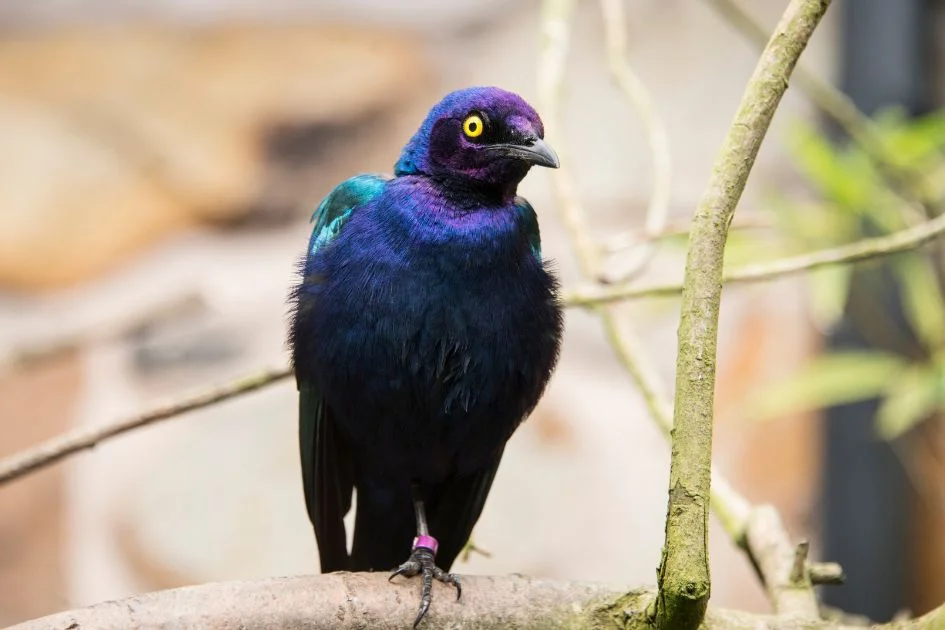
- Scientific Name: Lamprotornis purpureus
- Range: Africa
- Habitat: Open woodland
- Conservation Status: Least Concern
The purple starling comes from the Sturnidae family, a starling family. It is also known as the purple glossy starling, and it can be found in tropical Africa, specifically in countries like Senegal and Sudan.
Habitats it stays at include open woodlands and cultivation. True to its name, the purple starling is colored purple on its head and body, with green wings.
With a height that falls between 22 to 23cm, these birds aren’t too small. They feed on both fruits and insects and are known to be vocal.
6. Varied Bunting
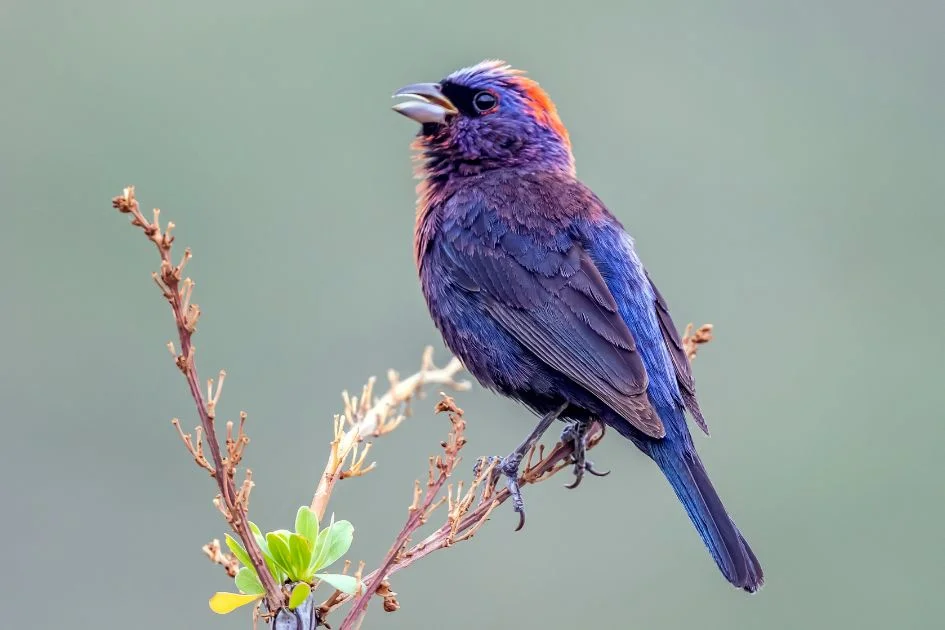
- Scientific Name: Passerina versicolor
- Range: North America
- Habitat: Desert, scrublands
- Conservation Status: Least Concern
Varied bunting belongs to the Cardinalidae family, also known as the cardinals. This is a songbird (or passerine) species, living in countries like the United States (Arizona, New Mexico, Texas) and Mexico. Preferred habitats include deserts and scrublands.
Varied buntings are omnivores and stay on the ground, feeding on insects, fruits, and seeds. The male varied bunting is a mix of purple and red, while the female is a light brown.
7. Violet Sabrewing
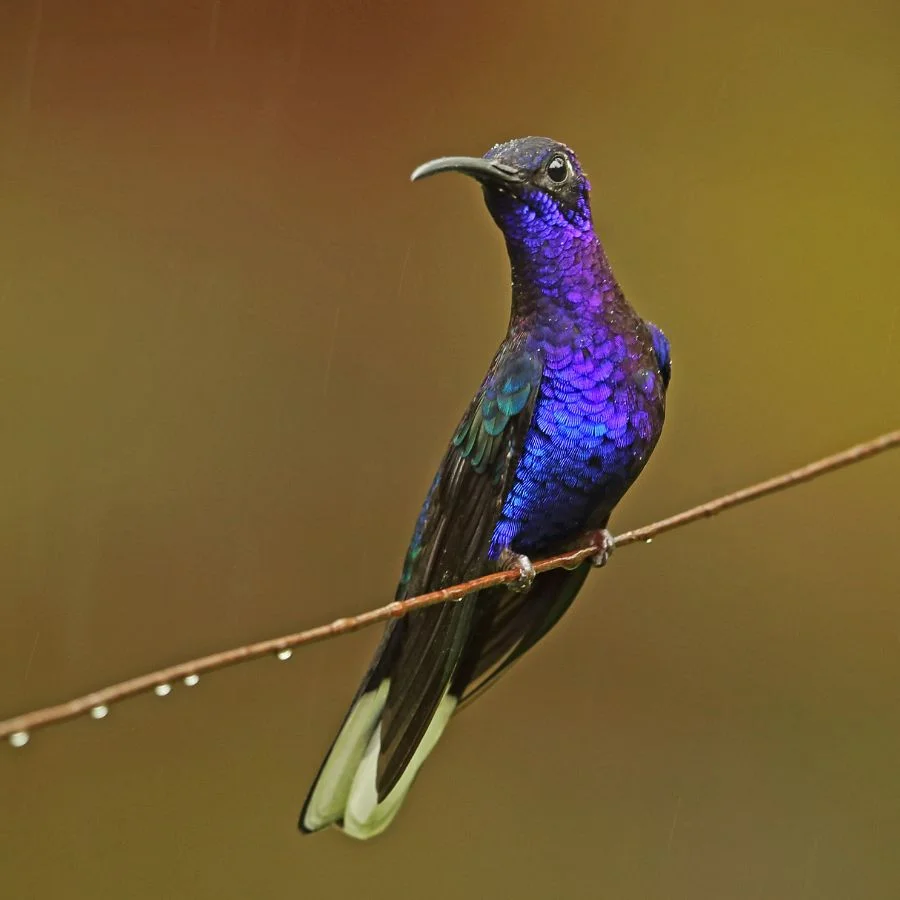
- Scientific Name: Campylopterus hemileucurus
- Range: Americas
- Habitat: Forests
- Conservation Status: Least Concern
The violet sabrewing is found in different parts of the American regions, from the North to the central down to the South.
Areas where the violet sabrewing lives include Mexico, Costa Rica, and Panama. It is a large hummingbird, and one of the largest that exists. Its main habitat is the forest.
The male violet sabrewing is colored violet in all areas except the back (which is green). Females only have violet on the throat. Their main colors are dark green and grey.
8. Purple Grenadier

- Scientific Name: Granatina ianthinogaster
- Range: Africa
- Habitat: Shrublands
- Conservation Status: Least Concern
The purple grenadier is a bird species under the Estrildidae family, otherwise known as the estrildid finches, and the birds in this family are passerine.
You’d find this bird species in countries like Ethiopia, Somalia, South Sudan, Tanzania, and Uganda, and it inhabits tropical and sub-tropical shrublands.
Purple grenadiers are small birds, measuring up to 5.25 inches. All their tails are black, while the bills are red amongst the adults.
Males have purplish colors on their rumps and underparts, while females are mostly cinnamon brown with a white underpart. Both sexes have patches on their eyes.
9. Violet-crowned Woodnymph
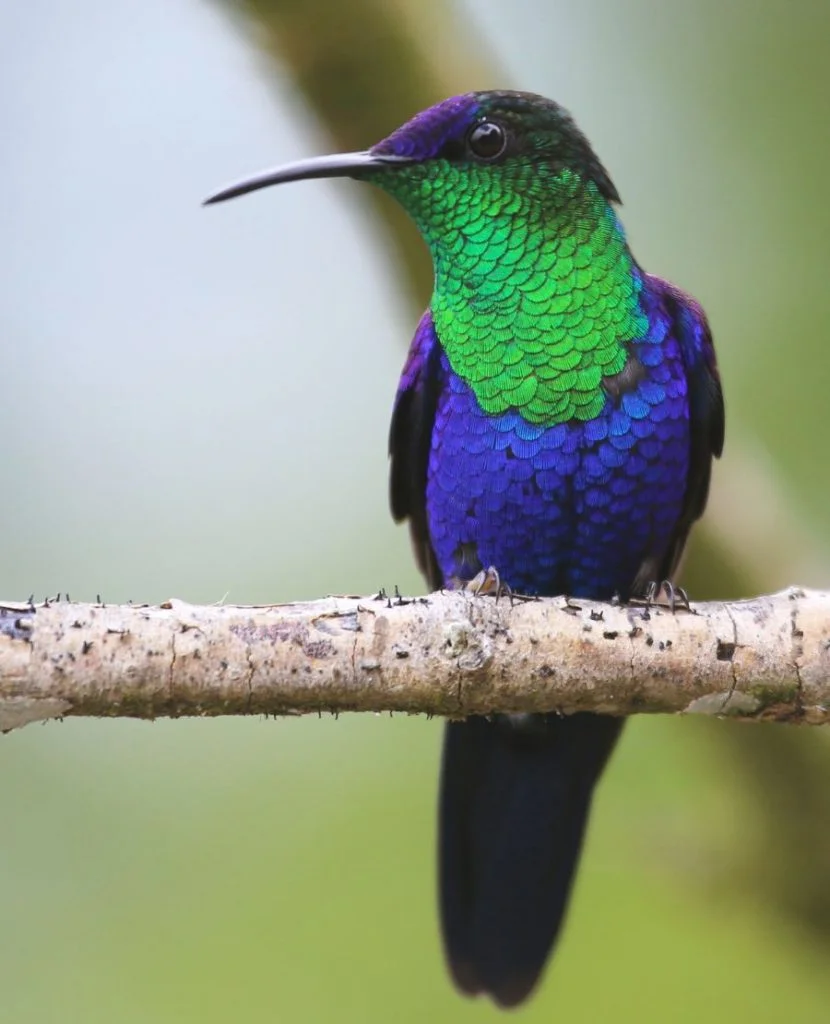
- Scientific Name: Thalurania colombica
- Range: Belize, Guatemala, Peru
- Habitat: Forest
- Conservation Status: Least Concern
The violet-crowned woodnymph is in the Trochilidae family, often located in Guatemala, Peru, and Belize. It inhabits forests, specifically subtropical and tropical ones, with a lot of moisture within.
This bird measures 10.2cm and weighs up to 4.5g. Both the male and female have violet crowns, but the adult male has more purple color overall than the female. Nectar is the violet-crowned woodnymph’s diet, but not its only meal. It can also feed on insects.
10. Violet-bellied Hummingbird

- Scientific Name: Chlorestes julie
- Range: Americas
- Habitat: Forests
- Conservation Status: Least Concern
The violet-bellied hummingbird’s name already tells us all we need to know about the bird. It belongs to the Trochilidae family. Hummingbirds in general have over 361 species and 113 genera.
From the family comes the violet-bellied hummingbird. It is native to countries in the American continents like Panama, Colombia, and Peru.
The preferred habitats of the violet-bellied hummingbird are different forms of forests, from humid deciduous forests to regrowth forests. As the name shows, its belly is colored violet.
11. Purple-bearded Bee-eater
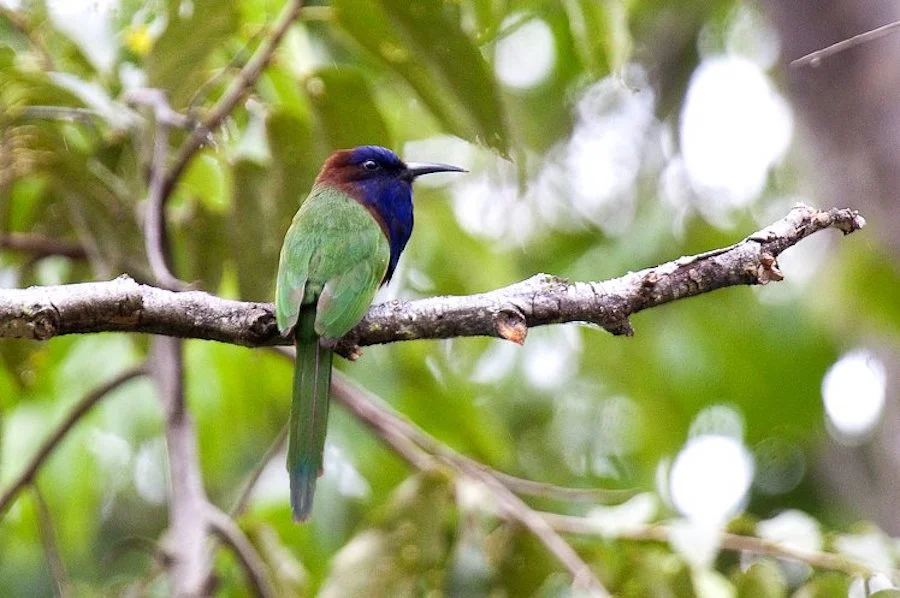
- Scientific Name: Meropogon forsteni
- Range: Indonesia
- Habitat: River banks, cliffs, cuttings
- Conservation Status: Least Concern
The purple-bearded bee-eater comes from the Meropidae family, also called the bee-eater family. It can be found only on the island of Suwesi in Indonesia, but it isn’t an endangered species or even near threatened.
These birds live in burrows close to river banks, cliffs, and cuttings. They don’t form colonies like some other bird species, but you can find some in pairs.
Bees are their main diet (obviously) but they also feed on other insects like wasps, beetles, and dragonflies. A distinguishing feature of this bird is the beard.
12. Purplish Jay

- Scientific Name: Cyanocorax cyanomelas
- Range: Americas
- Habitat: Forests
- Conservation Status: Least Concern
The purplish jay is from the Corvidae family, a bird family that regroups the nutcrackers, crows, ravens, jays, magpies, and many others.
They are passerine birds like a couple of others on this list, and they’re the largest. The purplish jay can be found in countries like northern Argentina, Bolivia, southern Brazil, and Paraguay.
Preferred habitats are different forests like the subtropical or tropical dry forests and lowland forests. They feed on insects, eggs, reptiles, and fruits.
13. American Purple Gallinule

- Scientific Name: Porphyrio martinicus
- Range: Americas
- Habitat: Freshwater marsh
- Conservation Status: Least Concern
The purple gallinule comes from the Rallidae family, which also consists of the crakes and coots. Typical of its family, the purple gallinule lives more on the ground.
This bird can also be called the yellow-legged gallinule. It can be found in the United States, Mexico, the Caribbean, and Central America.
This is a medium-sized bird that measures between 10 to 15 inches in height. Males are slightly bigger than females, and both have purple-blue feathers.
The purple gallinule is an omnivore, and it feeds on seeds, leaves, fruits, aquatic plants, insects, spiders, frogs, snails, etc.
14. Purple-breasted Sunbird
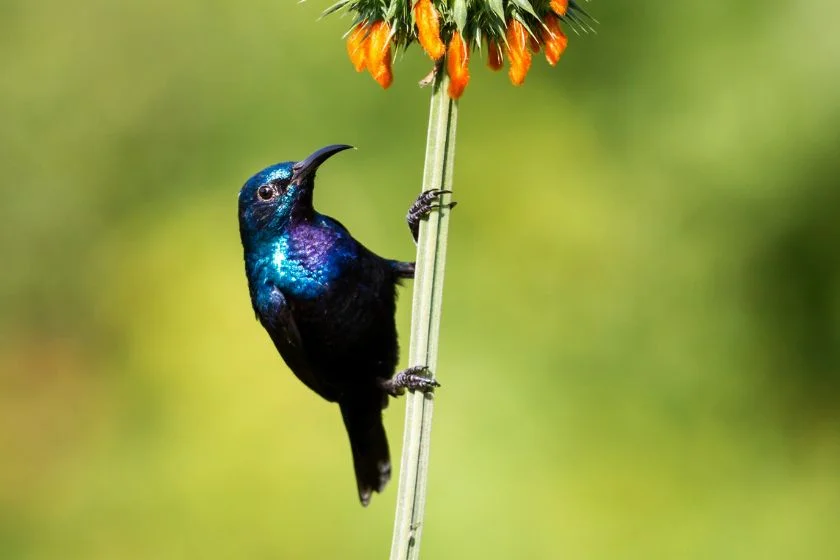
- Scientific Name: Nectarinia purpureiventris
- Range: Africa
- Habitat: Rainforest, secondary forest, open woodland
- Conservation Status: Least Concern
The purple-breasted sunbird is a member of the Nectariniidae family, known for having bright feathers. A couple of them also have long tails.
The purple-breasted sunbird is a native of the African continent in countries like Uganda, Burundi, Rwanda, and the Democratic Republic of the Congo. Similar to members of its family, this sunbird species inhabits open woodlands, rainforests, savannah, etc.
It is a diurnal bird and can get territorial to the point of being aggressive. Its main meal is nectar, making it a pollinator. The name is derived from the purple color of the breast area.
15. Japanese Paradise Flycatcher
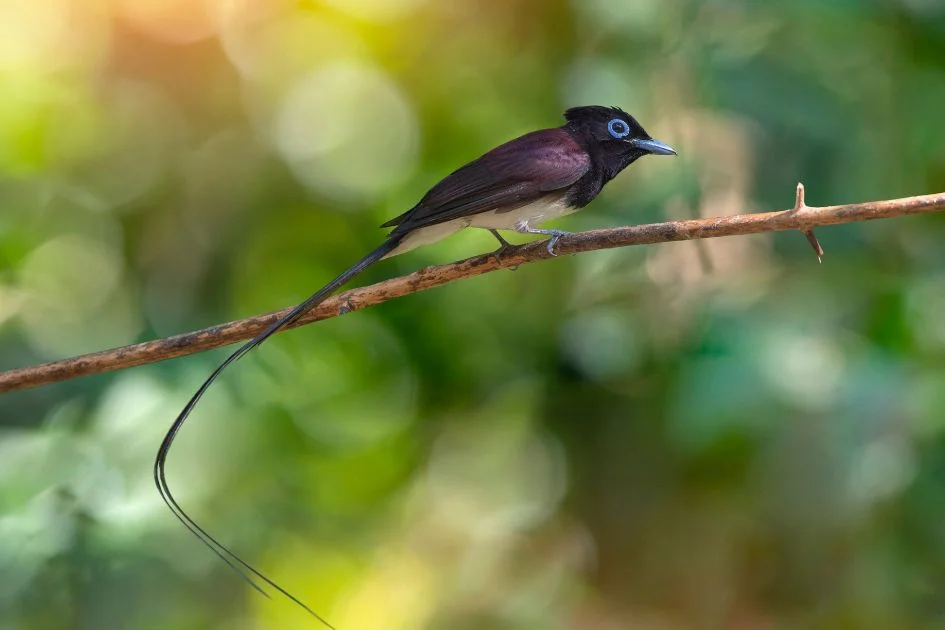
- Scientific Name: Terpsiphone atrocaudata
- Range: Asia
- Habitat: Forests
- Conservation Status: Near Threatened
The Japanese paradise flycatcher is from the Monarchidae family, also called the monarchs. Another name for the Japanese paradise flycatcher is the black paradise flycatcher.
While the name suggests that it hails from Japan, you can also find the Japanese paradise flycatcher in other Asian countries like China and Taiwan. The paradise flycatcher inhabits different forests within its range.
The male has a black to dark purple color, with some chestnut and white. Females are more orange and have shorter tails. The paradise flycatcher feeds on insects, nectar, fruits, spiders, and frogs. It is considered “near threatened” because of its dwindling number.
16. Purple-crested Turaco
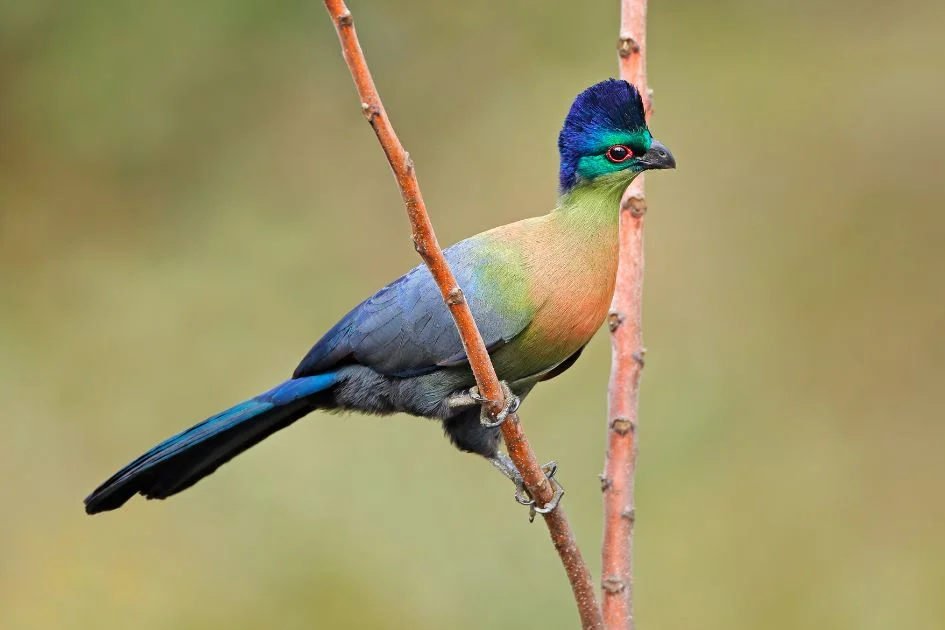
- Scientific Name: Gallirex porphyreolopus
- Range: Africa
- Habitat: Forests
- Conservation Status: Least Concern
The purple-crested turaco was once considered a member of the Musophagidae family but has now been classified under the Turacos.
It is found in many African countries, some of which are Burundi, Kenya, Malawi, Rwanda, Mozambique, and South Africa. South Africans call this bird the purple-crested loerie.
This bird species is mainly a frugivore, and are known to transport seeds back to their nests. It sports a purple color on its crest and body, green on the head, and green and brown on the chest and neck.
17. Western Violet-backed Sunbird
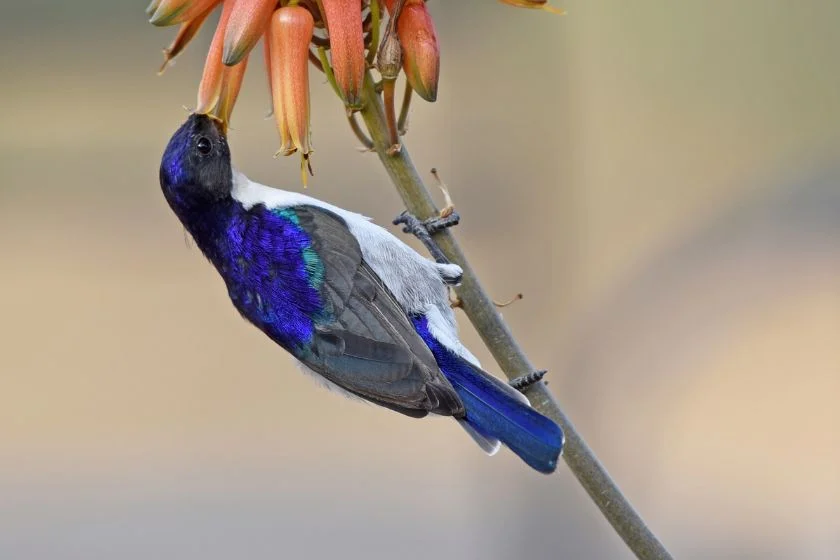
- Scientific Name: Anthreptes longuemarei
- Range: Africa, Asia
- Habitat: Woodlands
- Conservation Status: Least Concern
The western violet-backed sunbird is also known as the Longuemare’s sunbird and it comes from the Nectariniidae family. Its range is Subsaharan Africa, mainly the woodlands. Some sources also place them in Sri Lanka and Asia.
This bird’s back is a noticeable violet, but other parts have different colors. The wings and chest of the male are red, while the females don’t have red wings.
18. Common Scimitarbill
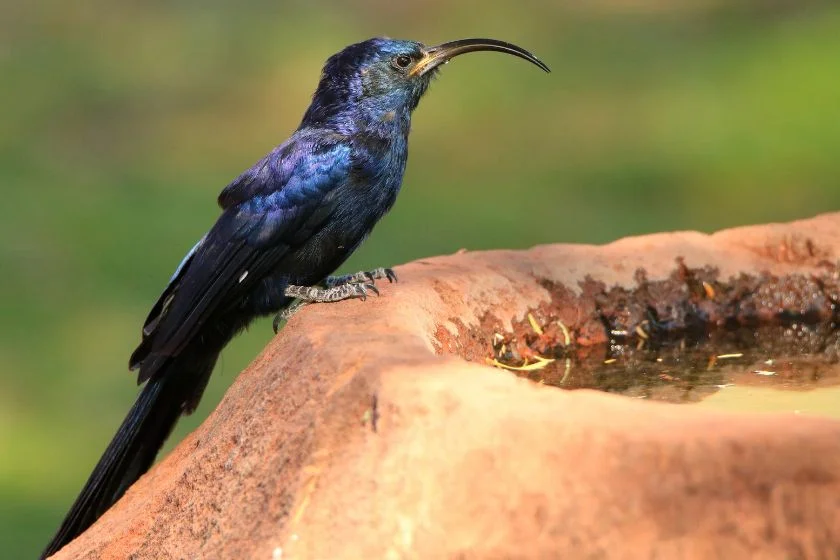
- Scientific Name: Rhinopomastus cyanomelas
- Range: Africa
- Habitat: Open woodland, savannah, thornbush
- Conservation Status: Least Concern
The common scimitarbill belongs to a small African bird family named Phoeniculidae, also known as the wood hoopoes. Wood hoopoes are not migratory, and that includes the common scimitarbill.
It can be found in countries like Angola, Botswana, Burundi, the Democratic Republic of the Congo, and Zimbabwe. Preferred habitats include open woodlands, savannahs, and thornbushes.
The common scimitarbill adult is purple on most parts, but the male has some yellow and the female comes with a combination of brown and gray.
19. Velvet-fronted Nuthatch
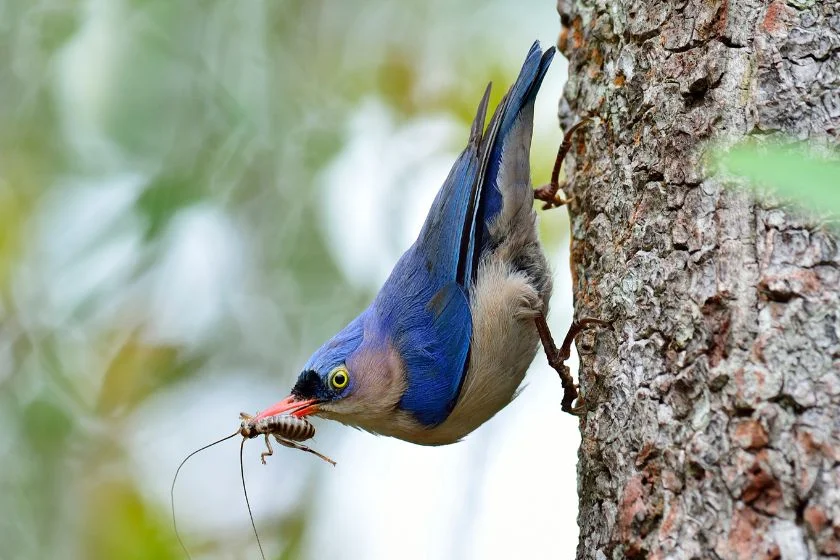
- Scientific Name: Sitta frontalis
- Range: Asia
- Habitat: Forests
- Conservation Status: Least Concern
The velvet-fronted nuthatch is from the Sittidae family, also known as the nuthatch family. The species is mainly in Asia, specifically in countries like India, Nepal, and Sri Lanka. Its preferred habitats are forests.
The velvet-fronted nuthatch is violet-blue on the top part and white underneath. It feeds on insects and spiders.
20. Purple-winged Roller

- Scientific Name: Coracias temminckii
- Range: Indonesia
- Habitat: Forests
- Conservation Status: Least Concern
The purple-winged roller lives only in Indonesia, specifically the Surawesi subregion. It belongs to the Coraciidae family, which is described as a family of old-world birds.
Birds in this family are known as rollers, which explains why this species is called the purple winged roller. The purple winged roller has two beautiful purple wings, with other colors like olive and azure blue on other parts.
Both genders are similar. The purple-winged roller feeds on invertebrates and vertebrates like rodents, lizards, frogs, and even other birds.
21. White-breasted Ground Dove
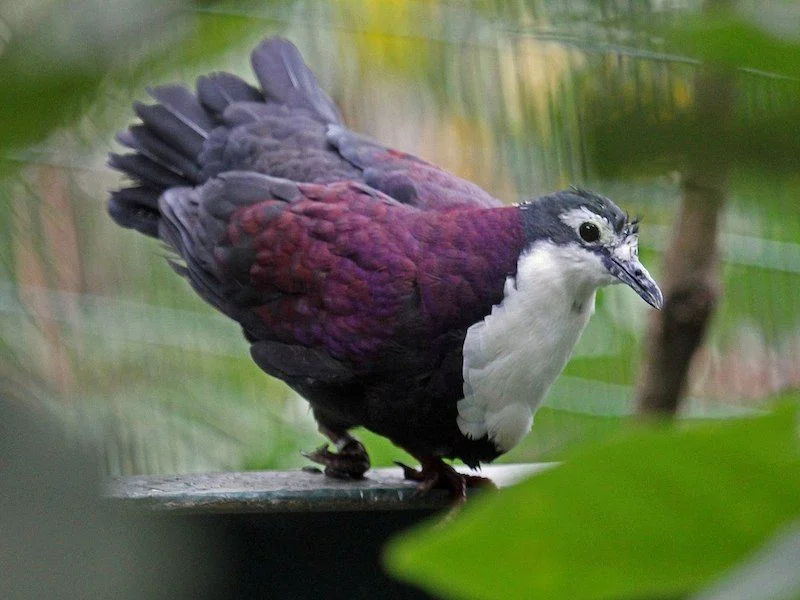
- Scientific Name: Pampuna jobiensis
- Range: New Guinea, Solomon Islands, Bismarck Archipelago
- Habitat: Forests
- Conservation Status: Least Concern
The white-breasted ground dove can also be called the purple ground dove or the white-bibbed ground dove. It belongs to the Columbidae family, one that regroups both doves and pigeons.
It can be found in islands like New Guinea, the Solomon Islands, and the Bismarck Archipelago. Its preferred habitats are forests. This ground dove is so named because of the white color on its breast area. The upper part is purplish, as well as the wings and tail.
The female has some red color on her eyes and beak that the male doesn’t have. It feeds on seeds, berries, leaves, etc.
22. Purple Cochoa

- Scientific Name: Cochoa purpurea
- Range: Asia
- Habitat: Forests
- Conservation Status: Least Concern
The purple cochoa is classified under the thrushes family, known as the Turdidae. It is often found in the Asian continent, where it stays in forested areas. Countries, where it lives, include China, Bangladesh, Bhutan, India, Thailand, and Nepal.
This bird is quiet and tends to isolate itself in the forests, where it sits on trees and shies away from contact. The males have purplish colors on the back and wings, but the females have a rufous color.
23. Rufous-vented Ground Cuckoo

- Scientific Name: Neomorphus geoffroyi
- Range: Americas
- Habitat: Forests
- Conservation Status: Vulnerable
The rufous-vented ground cuckoo belongs to the Cuculidae family, also called the cuckoo family. Besides cuckoos, there are also roadrunners, koels, malkohas, and some other bird species under the cuckoo family.
Rufous-vented can be found in many American countries like Colombia, Ecuador, Peru, Bolivia, and Brazil.
The upper parts and tail of this bird come with a purple color, but other parts are colored brown, green, white, and/or a pale tan. It is not so easily seen as the population has dwindled, and as such, it is considered vulnerable.
24. Purple-crowned Fairywren
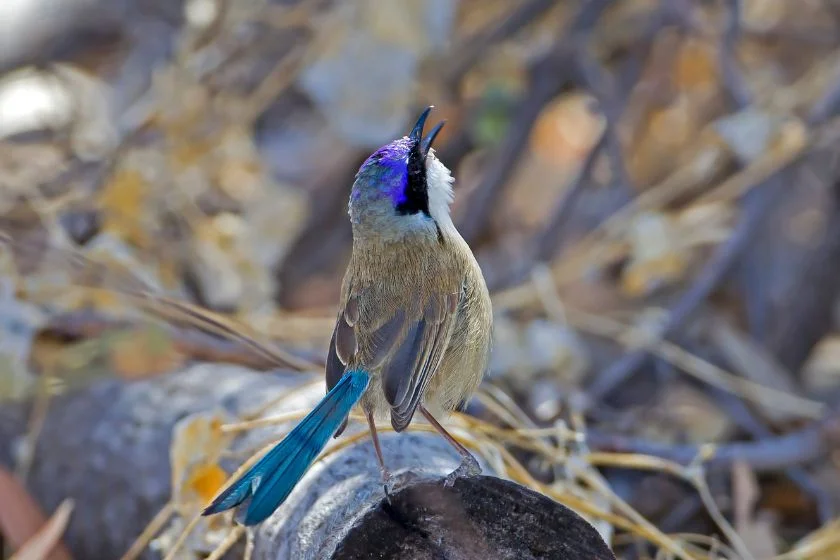
- Scientific Name: Malurus coronatus
- Range: Australia
- Habitat: Tropics
- Conservation Status: Least Concern
The purple-crowned fairywren’s scientific name coronatus is derived from the Latin corōna which means “crown” and is directly tied to the purple crown on this bird’s head.
It belongs to the Maluridae family, all of which are native to Australia. This bird inhabits the wet tropics in Australia.
This bird is generally brown, but with a blue tail and a purple crown. The latter earned it a good spot on our list. These birds are socially monogamous, and they are very vocal as well.
25. Costa’s Hummingbird
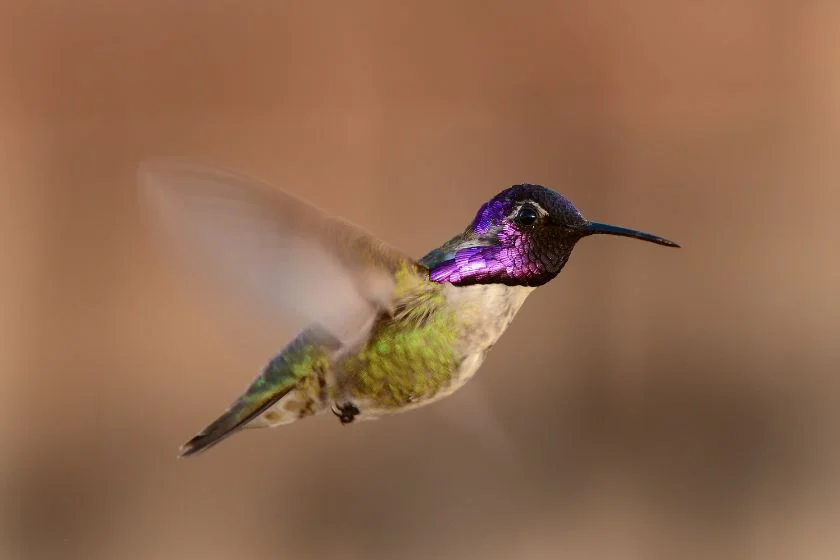
- Scientific Name: Calypte costae
- Range: North America
- Habitat: Deserts
- Conservation Status: Least Concern
Costa’s hummingbird belongs to the Hummingbird family named Trochilidae. It can be found in the deserted areas of the United States and Mexico. You can also see some in gardens.
The Costa’s hummingbird is a tiny bird with different colors, from green to black down to the purple cap on its head and throat. It feeds on nectar and insects.
26. Fork-tailed Woodnymph
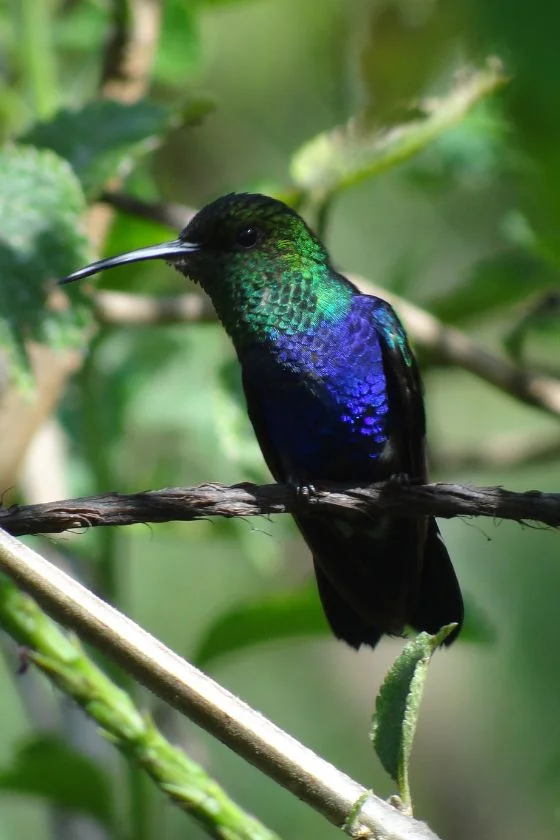
- Scientific Name: Thalurania furcata
- Range: Americas
- Habitat: Forests
- Conservation Status: Least Concern
The fork-tailed woodnymph belongs to the Trochilidae family, similar to Costa’s hummingbird. It can be found in different American countries like Argentina, Brazil, Bolivia, Ecuador, Colombia, Paraguay, and Peru.
The preferred habitats of the fork-tailed woodnymph are forests, from the moist lowland kind to the moist montane forest. The male fork-tailed woodnymph is purple, blue, or violet while the female tends to be gray or brown.
This bird feeds on nectar, spiders, berries, and different forms of insects. While it is related to the hummingbird, it doesn’t share the main attribute hummingbirds have, which is humming while flying.
27. Wompoo Fruit Dove
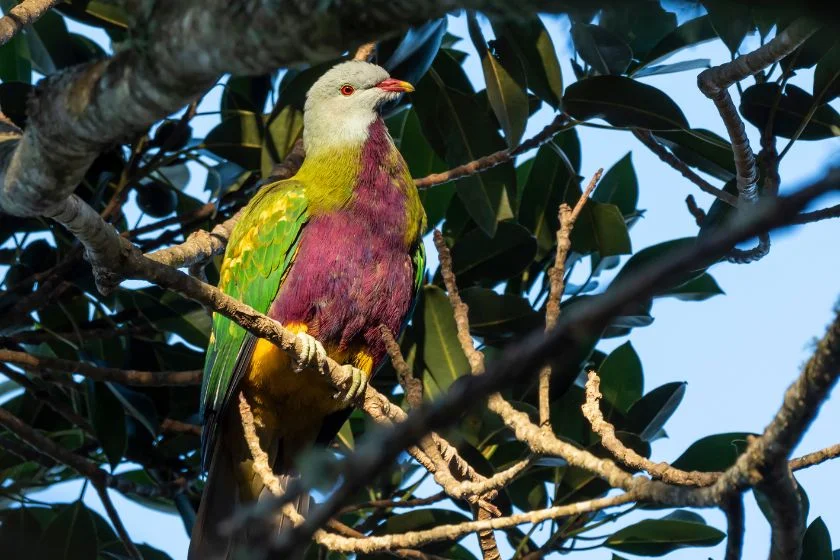
- Scientific Name: Ptilinopus magnificus
- Range: Australia, New Guinea
- Habitat: Rainforests
- Conservation Status: Least Concern
The wompoo fruit dove is a member of the Columbidae family, similar to the other dove bird on this list. It is one of many fruit doves—going up to 50—and is a large one.
Wompoo fruit doves can live in different habitats, and they often go to places with abundant food. The wompoo fruit dove’s purple color rests on its neck, chest, and upper belly. The purple doesn’t get to the lower belly, which is rather yellow.
The males tend to be more colorful than the females, but overall the differences are little. Notwithstanding their colorful nature, these birds are hardly seen due to their quiet lives.
28. Azure-crowned Hummingbird
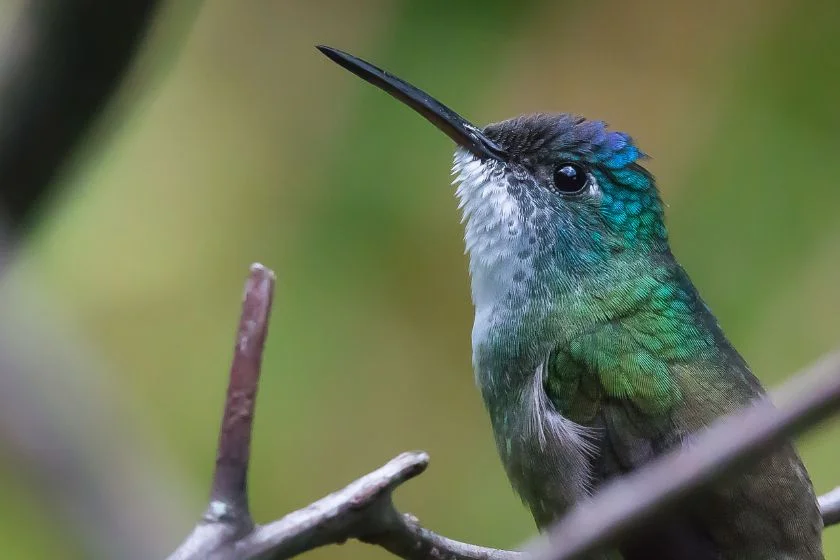
- Scientific Name: Saucerottia cyanocephola
- Range: South America
- Habitat: Montane forest
- Conservation Status: Least Concern
The azure-crowned hummingbird is in the Trochilidae family, the family of hummingbirds. It lives in different parts of South America, including Mexico, Honduras, Nicaragua, Belize, and Guatemala. Its preferred habitat is the montane forest, which is either subtropical or tropical.
Azure-crowned hummingbirds are bright, some might say too bright. They come in an attractive combination of different colors from the purplish wings to the green throat up to the blue head. These birds are polygamous.
29. Purple-Throated Woodstar
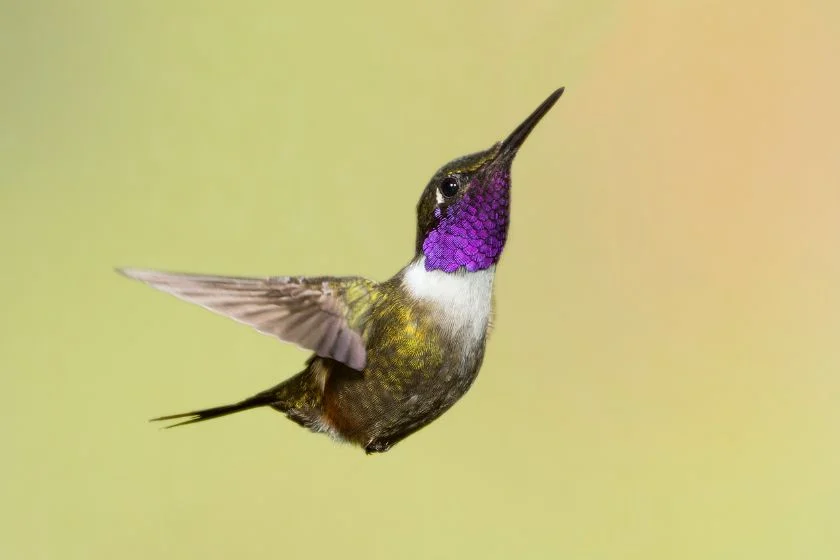
- Scientific Name: Philodice mitchellii
- Range: South America
- Habitat: Dense forest, brush
- Conservation Status: Least Concern
The purple-throated woodstar is a hummingbird and belongs to the hummingbird family, though it doesn’t reflect in its name. In its genus Philodice, it is one of two species. The species live in Columbia, Ecuador, and Panama. Its habitats include mountains and forests.
As the name shows, this bird’s throat is colored purple, though that’s reserved for the male. Females don’t have purple on their throats. The main diet is nectar and these birds can be quite territorial.
30. Hartlaub’s Turaco
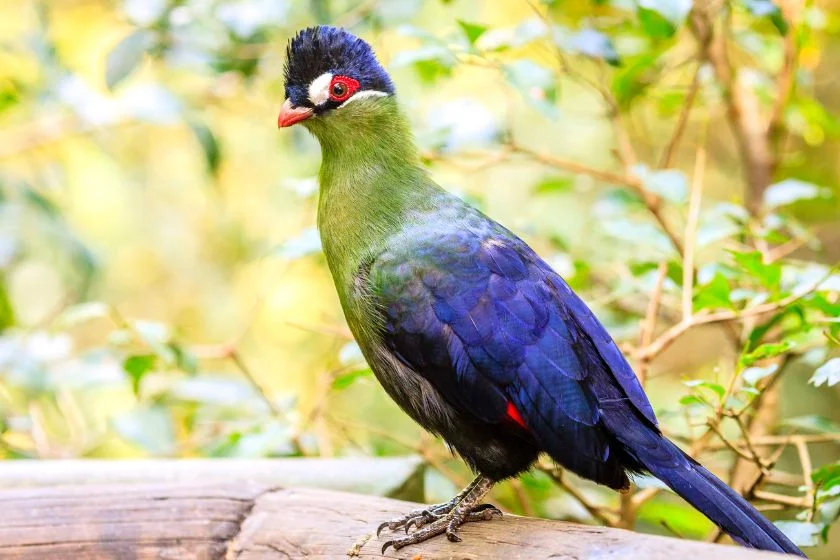
- Scientific Name: Tauraco hartlaubi
- Range: Africa
- Habitat: Savannah
- Conservation Status: Least Concern
The Hartlaub’s Turaco is in the Musophagidae family, and it can be found in African countries, specifically Kenya, Uganda, and Tanzania. It can also be found in Ethiopia and South Sudan, and its preferred habitat is the Savannah.
Not much is known about Hartlaub’s Turaco, but it is of least concern. The males are slightly larger than the female, but they both tend to have purple.
Conclusion
Have you ever seen one of these birds? If yes, consider yourself lucky. They are a beautiful sight to behold, and they make nature worth spending time in.
We’ve unveiled 30 of these birds, some of which have a combination of colors, like the bird with purple and green feathers and more.
Feel free to mention any other purple bird species that we might have missed.
Also Read:
30 Yellow Animals That Are Stunning (List & Pictures)
Reference: Nature Ecology & Evolution
Featured Image Credit: Michael Fitzsimmons / Getty Images






